Centauri Dreams
Imagining and Planning Interstellar Exploration
Planets Everywhere You Turn
Exactly what kind of planets can form around M-class dwarf stars is a major issue. After all, these stars, comprising 70 percent or more of the stars in the galaxy, are far more common than stars like the G-class Sun. About 5500 of the 160,000 stars the Kepler mission is looking at are M-dwarfs, and of these, 66 had been found to show at least one planetary transit signal at the time a new paper on M-dwarf planets was in preparation. That paper, the work of John Johnson and postdoc Jonathan Swift (Caltech) and team, homes in on the Kepler-32 system, whose five transiting planets offer a chance to study planet formation and frequency around such stars.
Kepler-32 is about half as massive as the Sun and has half its radius, with about 5 percent of its luminosity. The planets here have radii that range from 0.8 to 2.7 times that of the Earth, all of them orbiting within about a tenth of an astronomical unit from the star, a distance that is about a third of the radius of Mercury’s orbit around the Sun. The outermost of the five planets lies in the habitable zone. The Caltech team used Kepler data in correlation with observations from the Keck Observatory and the Palomar 60-inch telescope to characterize the system in detail. Two of the planets had already been confirmed, and the team has now confirmed the other three.
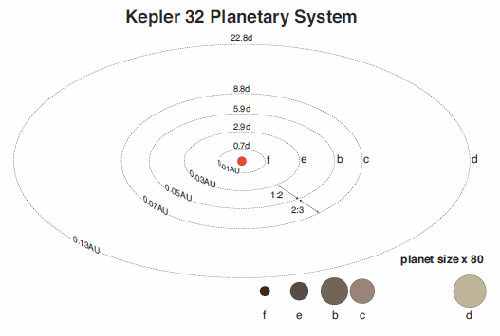
Image: — Depiction of the Kepler-32 planetary system with the star and orbits drawn to scale. The relative sizes of the planets are shown at the bottom of the figure scaled up by a factor of 80 in relation to their orbits. Credit: Jonathan Swift, John Johnson/Caltech.
Although the study is producing interesting material on planet formation, what’s capturing the bulk of press attention is the researchers’ estimate that there are at least 100 billion planets in the galaxy. It’s a conservative figure at that, because the analysis only includes planets in close orbits around M-dwarfs, leaving aside the issue of outer planets in such systems and planets orbiting other classes of star. To arrive at the figure, the team calculated the probability that an M-dwarf system would have the precise edge-on orientation we see with Kepler-32, combining that with the number of systems Kepler is able to detect. Even the conservative figure — essentially one planet for every star in the galaxy — is happy news for planet hunters, for it suggests that planets are the norm around the most common kind of stars in the Milky Way.
From the paper:
We select out 4682 M dwarfs from the Kepler Input Catalog that have been observed with Kepler and use their observational parameters to derive the planet occurrence rate of Kepler M dwarf planet candidates. We confirm that within the completeness limits of the first 6 quarters of Kepler data, the M dwarf planet candidates have an occurrence rate about 3 times that of solar-type stars, while the occurrence rate of all candidates around M dwarfs is 1.0±0.1. We expect the fidelity of our culled sample to be above 90%. Thus the compact systems of planets around the Kepler M dwarf sample are a major population of planets throughout the Galaxy amplifying the significance of the insights gleaned from Kepler-32.
The likelihood is that the five Kepler-32 planets formed much further out from the star and migrated inwards, one line of evidence being that the mass of the disk where the planets are found would be as much as three Jupiters, too much disk material for the space available based on our understanding of other proto-planetary disks. Moreover, the fact that M-dwarfs are brighter and hotter when young would have kept planet-forming dust from existing so close to the star. Yet a third line of reasoning is that the third and fourth planets of the system are not dense, implying they are composed of volatiles like carbon dioxide, methane or other ices and gases. Thus formation further out in the system with subsequent migration is the likely scenario.
The paper is Swift et al., “Characterizing the Cool KOIs IV: Kepler-32 as a prototype for the formation of compact planetary systems throughout the Galaxy,” accepted at The Astrophysical Journal (preprint).
Related: The Planetary Habitability Laboratory (University of Puerto Rico at Arecibo) notes that of the 18,406 ‘planet-like detection events’ released last month by the Kepler team, some 15,847 meet the criteria for study for possible inclusion in the institution’s Habitable Exoplanet Catalog. PHL analyzed and sorted the remaining candidates and was able to identify 262 potentially habitable worlds. These include four Mars-sized objects, 23 of Earth size, and 235 ‘super-Earths.’ The best candidate PHL sees thus far is an Earth-sized planet in a 231-day orbit around the star KIC-6210395, one that receives 70 percent of the light that Earth receives from the Sun. This interesting if preliminary analysis is reported in a news release wonderfully titled (with a nod to ‘Contact’) ‘My God, it’s full of planets! They should have sent a poet.’

Dynamics of an Interstellar Probe
Yesterday’s look at radiation and its effects on humans in space asked whether any Fermi implications were to be found in the work described at the University of Rochester. One answer is that expansion into the cosmos does not need to be biological, for biological beings can build robotic explorers equipped with enough artificial intelligence to get the job done. A truly advanced civilization would be able to create large numbers of intelligent probes or, indeed, self-replicating probes that could spread throughout the galaxy on a timescale of perhaps ten million years.
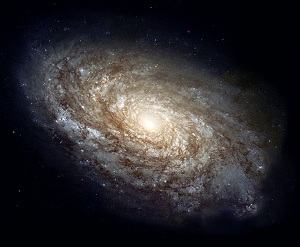
Fermi speculation is always fun but, when we get into the motivations of extraterrestrial civilizations, it leads inevitably to unfalsifiable solutions, good for conversation over coffee but incapable of producing a scientific result. Thus the ‘zoo hypothesis,’ the notion that the Earth is intentionally left alone to pursue its own development by beings with an agenda of their own. It makes for terrific science fiction, but how much can we say about alien sociology? Working with two colleagues at the University of Edinburgh, Duncan Forgan thinks we’d be better off studying the physical constraints that might govern an expanding wave of galactic exploration.
Image: The spiral galaxy NGC 4414, as imaged by the Hubble Space Telescope. Can simulations help us understand how a galaxy of hundreds of billions of stars can be explored by a single civilization? Credit: NASA.
Forgan argues that even in our early exploration of the Solar System, we’ve learned the value of gravitational ‘slingshot’ maneuvers that let us produce velocity and trajectory changes without the use of fuel. Simple powered flight is an inefficient way to travel, especially in our era of chemical rocketry and, presumably, in the coming era of nuclear propulsion methods. At the galactic level, probes can be accelerated relative to the galactic rest frame by similar techniques. Forgan and team run simulations analyzing the ways a single probe can move through a population of stars.
Specifically, the researchers work with three scenarios: 1) The ‘powered’ approach, in which a single probe simply moves between stars by targeting the nearest unvisited neighbor; 2) The ‘slingshot’ approach, using gravitational slingshot methods to move along the same course as in scenario 1; and 3) The ‘maxspeed’ approach, where a probe selects the next destination star in such a way as to get the biggest benefit from a slingshot maneuver — all this depends on the destination’s star’s velocity relative to the current star being approached. The three simulation scenarios were carried out in a field of 1 million stars at a density of 1 star per cubic parsec.
What Forgan and team are looking for is the effect of these different strategies on relative travel times, as the paper notes:
We select a relatively low maximum velocity of 3 X 10-5c, where c is the speed of light in vacuo. This is comparable to the maximum velocities obtained by unmanned terrestrial probes such as the Voyager probes. Admittedly, the Voyager probes achieved these speeds thanks to slingshot trajectories, so the top speed of human technology under purely powered flight is unclear. To some extent, the maximum powered speed of the probe is less important – increasing or decreasing this maximum will simply affect the absolute values of the resulting travel times in a similar fashion. What is more important is the relative effect of changing the propulsion method and/or the trajectory.
The slingshot trajectory turns out to have a significantly shorter travel time than either the powered or maxspeed approaches, following the same course as the ‘powered’ probe but able to boost its velocity at every stage of the journey. In fact, Forgan’s simulations show the probe will have increased its velocity by close to a factor of 100 in the course of the simulations. The ‘maxspeed’ scenario optimized for velocity but did not consider the distance to the next star, creating lengthy journeys between widely spaced stars in the early stages of the exploration.
Forgan notes that with the current speed limitations of human probes, the galaxy could not be explored with a single probe in the lifetime of the universe, but the use of multiple probes changes the picture entirely:
Given our current ability to manufacture large numbers of similar sized craft for terrestrial uses, it is not unlikely that we can adopt a similar approach to building probes. A simple calculation shows that producing 1011 Voyager-esque probes would allow humankind to explore the Galaxy in 109 years. Given that around 5 X 107 automobiles are produced each year globally, it seems reasonable to expect a coordinated global effort could produce the requisite probes within a few thousand years. If the probes are made to be self-replicating, using materials en route to synthesize copies, the exponential nature of this process cuts down exploration time dramatically.
Whatever the case — a fleet of probes created by an extraterrestrial civilization or an exponentially growing fleet of probes each engaged in self-replication — adding gravitational slingshot dynamics into the mix can shorten travel times and strengthen the Fermi paradox. Slingshot effects reduce a single probe’s travel time by two orders of magnitude. Forgan’s team is now repeating the analysis of this paper using self-replicating probes as the basis of exploring whether slingshot dynamics fit into the overall cost-benefit picture of that kind of expansion.
The paper is Forgan, Papadogiannakis and Kitching, “The Effect of Probe Dynamics on Galactic Exploration Timescales,” accepted for publication in JBIS (preprint).

Radiation, Alzheimer’s Disease and Fermi
In a sobering start to the New Year, at least for partisans of manned missions to deep space, new work out of the University of Rochester indicates that galactic cosmic radiation may accelerate the onset of Alzheimer’s disease. The study, led by the university’s Kerry O’Banion, is hardly the first time that the impact of radiation in space has been studied, with previous work aimed at cancer risks as well as cardiovascular and musculoskeletal issues. But O’Banion’s work points to radiation’s effects on biological processes in the brain, reaching striking conclusions:
“Galactic cosmic radiation poses a significant threat to future astronauts,” said O’Banion. “The possibility that radiation exposure in space may give rise to health problems such as cancer has long been recognized. However, this study shows for the first time that exposure to radiation levels equivalent to a mission to Mars could produce cognitive problems and speed up changes in the brain that are associated with Alzheimer’s disease.”
Neurological damage from human missions to deep space — and the study goes no further than the relatively close Mars — would obviously affect our planning and create serious payload constraints given the need for what might have to be massive shielding. I’m already seeing this work being referred to (not by these researchers, to be sure) in the context of the Fermi paradox, which is an interesting speculation in itself, the idea being that if space is inherently hostile to human biology, these conditions may have prevented other species from tackling interstellar journeys. But before we get into that, let’s take a closer look at how the study was put together.
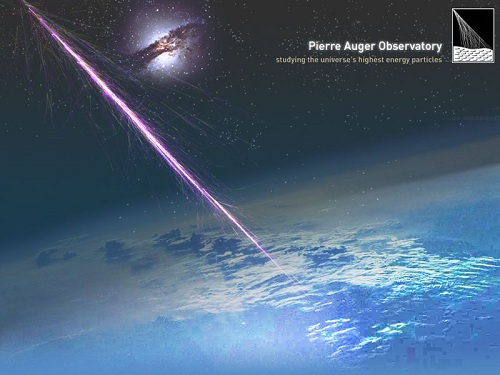
Image: An artist’s illustration of a cosmic ray striking the Earth’s atmosphere and creating a shower of secondary particles detectable on the surface. That high energy fundamental particles are barreling through the universe has been known for about a century. Because ultra high energy cosmic rays are so rare and because their extrapolated directions are so imprecise, no progenitor objects have ever been unambiguously implied. 2007 results from the Pierre Auger Observatory, however, indicate that 12 of 15 ultra high energy cosmic rays have sky directions statistically consistent with the positions of nearby active galactic nuclei. Whatever the source, does such space radiation present a show-stopper for manned missions to deep space? Credit: Robert Nemiroff & Jerry Bonnell / Pierre Auger Observatory Team.
At the heart of the work are high-energy, high-charged particles (HZE) which exist in low but continuous levels in deep space. Among the different HZE particles, the focus of the O’Banion team’s work is 56Fe — iron particles — which are speedy and massive enough to create serious shielding problems. To examine the issue, O’Banion exposed laboratory mice to doses of radiation comparable to what astronauts would experience on a trip to Mars, working partly at NASA’s Space Radiation Laboratory at Brookhaven National Laboratory (Long Island).
The mice were then put through a variety of experiments to gauge the cognitive and biological effect of the exposure. The result: Their encounter with radiation resulted in what the paper calls ‘enhanced AD [Alzheimer’s disease] plaque pathology,” with higher than normal accumulations of beta amyloid, the protein plaque now considered a marker for the disease. From the paper (internal references omitted for brevity):
The doses used in this study are comparable to those astronauts will see on a mission to Mars, raising concerns about a heightened chance of debilitating dementia occurring long after the mission is over. Increased plaque progression could be due to a variety of mechanisms. A primary mechanism of radiation injury is DNA damage and reactive oxygen species production that can contribute to overall cell dysfunction. In addition, radiation is also known to cause glial activation and inflammatory cytokine production, both of which have been implicated in neurodegenerative diseases like AD. In our study, GCR exposure could amplify the chronic inflammatory AD state and speed up pathology.
The mice were also run through experiments involving recall of objects and locations, with the researchers finding that the group exposed to radiation was far more likely to fail at these tasks, suggesting an earlier onset of neurological impairment than normal. The paper stresses this caveat: The mice were exposed to a single kind of galactic cosmic radiation at acute levels of exposure. “It is not known how the CNS [central nervous system] will respond to the complex and chronic low-dose GCR environment of space. Moreover, astronauts will not likely be familial AD carriers. Therefore, while many of the pathological processes are believed to be similar, this model does not reflect the complete human condition.”
So the model is tightly focused, but the one aspect of deep space radiation the researchers can replicate is troubling. Whole body exposure to 56Fe particle HZE radiation appears to enhance the progression of Alzheimer’s disease. You can read more about this work in this University of Rochester news release. The paper itself is Cherry et al., “Galactic Cosmic Radiation Leads to Cognitive Impairment and Increased A? Plaque Accumulation in a Mouse Model of Alzheimer’s Disease,” PLoS ONE 7(12): e53275 (available online).
Back briefly to the Fermi issue, which in my judgment remains unaffected by the question of radiation danger. We do not need to assume that a wave of interstellar probes, whether self-replicating or not, would have to be manned by biological creatures. In fact, assuming they’re not, we can stop worrying about mission times of a human life-span or less and think about a galaxy penetrated by artificial intelligence gradually moving from star to star, perhaps leaving observation stations along the way. Given enough time, the galaxy would be infused with the technology of a single species which would never need to expose itself to deep space.

A New Year Awaits
I’ve gotten so used to thinking ‘maybe this will be the year when the first Alpha Centauri planet is discovered’ that I almost said it again about 2013. Fortunately, we already have a (still unconfirmed) Centauri B b, and the latest I’ve heard is that it may take five years or so before we can say something definitive about a planet in a habitable zone orbit around our neighboring system. So the coming year may not be the year of Alpha Centauri, but we can expect exoplanet news in abundance as the various teams continue their work, and plenty of activity from the organizations now working to advance the idea of interstellar flight through papers, conferences and commentary. Let me wish all Centauri Dreams readers the best for a dazzling new trip around the Sun.

Planet Discovery Through Disk Structure
As the number of confirmed planets and planet candidates has grown, we’ve gone through a variety of techniques for exoplanet hunting, as Michael Lemonick’s new book Mirror Earth: The Search for Our Planet’s Twin (Walker & Co., 2012) makes clear. I’m only a third of the way into the book but I bring it up because it’s germane to today’s discussion in two ways. The first is purely administrative. Readers of Centauri Dreams are used to seeing information about the book I’m reading on the front page, but as many emails have reminded me, lately it’s been absent.
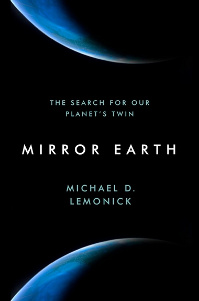
What’s happening is this: The software I use to display the book cover and progress bar is no longer being maintained by its creator, and the program has become flaky. I’ve discovered more and more that certain books will not display properly, so that although I can enter them in the configuration file, nothing shows up in the sidebar on the home page. As a result, I’m searching for alternatives that will display titles like Mirror Earth and anything else I’m currently reading.
But even though I’m early on in my progress through Lemonick’s book, I can already recommend it for the overview it provides. Lemonick writes for TIME and has written skillfully about astronomy’s history (William and Caroline Herschel were the topic of a recent book) and cosmology. He was an early entrant into exoplanet books with 1998’s Other Worlds. In short, Lemonick knows what he’s up to, and he offers the general reader a concise set of discussions with major exoplanet figures and a cogent history of how the field developed.
Astrometry was an early entrant in the exoplanet hunt as astronomers hoped to identify the side-to-side motion of a star being tugged by its planet, but early ‘discoveries’ made with the method proved bogus, and radial velocity emerged as the technique of choice, focusing on the movement of the star to and away from the Earth as measured by Doppler shift. We soon learned the effectiveness of transits (Kepler uses this method) and investigated gravitational lensing and, in rare cases, succeeded at direct imaging. What other methods will emerge?
As I proceed with the book, I’m also looking at recent news from the planet hunting HiCIAO ( High Contrast Instrument for the Subaru Next Generation Optics), used by an international team with the Subaru Telescope on Mauna Kea. HiCIAO has ways of blocking out the central star to help astronomers detect faint objects like planets or dust disks around it. The new work presents studies of the disk around the young star (about 9 million years old) HD 135344B, some 460 light years from Earth in the constellation Lupus. The disk under measurement is 20 billion kilometers in radius, which is about five times greater than Neptune’s distance from the Sun.
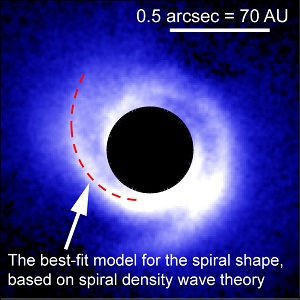
This is intriguing stuff because the team is looking at a spiral disk structure with two discernible arms. Applying density wave theory to the data, the researchers conclude that planets embedded within the disk may account for the spiral shape, and in doing so, they may be revealing another way of detecting exoplanets. The idea here is that regions of enhanced density develop inside a rotating disk because of differential rotation. A planet within the disk could produce the kind of density wave that results in the formation of just this kind of spiral structure. From the paper: “While we cannot uniquely identify the origin of these spirals, planets embedded in the disk may be capable of exciting the observed morphology. Assuming that this is the case, we can make predictions on the locations and, possibly, the masses of the unseen planets.”
Image: A comparison of the fit between the theoretical model and observational data. The red dashed line represents the shape of the disk based on modeling from density wave theory. The image shows that the data conform to the predictions of the theory and supports an explanation for the development of the structure in terms of this theory’s model. (Credit: NAOJ).
So far no planet candidate has emerged — we are simply considering the possibility that a planet is the cause of the density wave. But the use of density wave theory in measuring a protoplanetary disk helps us to understand how spiral disks form, and it may develop into a more precise way to detect exoplanets. The paper on this work suggests that HiCIAO may be capable of detecting the indirect signatures of planets down to 0.05 Jupiter mass, but it will take future observations at other wavelengths to see whether such predictions are borne out in fact.
The paper is Muto et al., “Discovery of Small-Scale Spiral Structures in the Disk of SAO 206462 (HD 135344B): Implications for the Physical State of the Disk from Spiral Density Wave Theory,” in Astrophysical Journal Letters 748 (April 2012), L22, 2012 (abstract).

Alpha Centauri in Perspective
In his new article on Alpha Centauri in Astronomy & Geophysics, Martin Beech (Campion College, University of Regina) noted that the Alpha Centauri stars seem to go through waves of scientific interest. Beech used Google’s Ngram Viewer to look for references to the system in both the scientific literature as well as general magazines and newspapers, finding that there is a 30-year interval between peaks of interest. The figure is suspiciously generational, and Beech wonders whether it reflects an awakening of interest in this nearby system as each generation of scientists and publishers arises.
I mentioned on Christmas Eve that the Beech paper was a real gift for the holidays, and for those of us who try to track developments about Alpha Centauri, it certainly is, drawing together recent work and commenting with care on the findings. The big issue for now is the existence of planets around these stars, a question Centauri B b will begin to answer if it can be confirmed. Everyone from astrophysicists to science fiction authors has noted at one time or another that we may have planets around all three of these stars, no doubt fueling that thirty-year spike Beech identified.
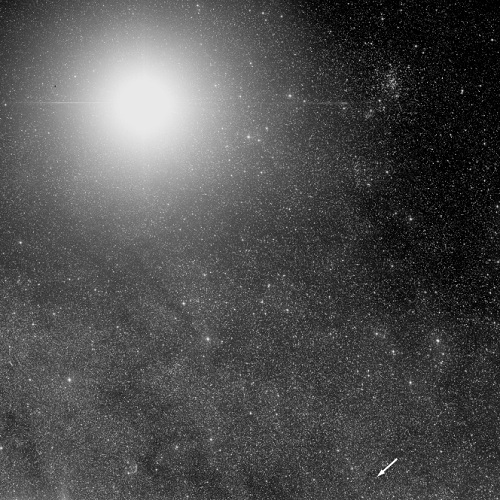
Image: Despite the overexposure of Centauri A and B that fuses the two stars into one at top left, I like it because it reveals Proxima Centauri (shown by the arrow at bottom right), an indication of how distant this nearest star to the Sun is from the two larger stars. Credit: 1-Meter Schmidt Telescope, ESO.
I remember a long-ago sixth grade afternoon when I asked the teacher, after a presentation about astronomy, whether the nearest star had planets like ours around it. After class, she slipped me a book to look at whose title is long lost to memory, but I recall it being stated with confidence that planets were all but impossible around binary stars. Now we know better, for we have planets around binaries elsewhere. As for Alpha Centauri, it was in 1997 that Paul Wiegert and Matt Holman showed that planetary orbits were viable here out to about 4 AU around Centauri A and B.
That would seem to rule out gas giants, which presumably would have formed beyond the snow line at roughly the same 4 AU and beyond, but terrestrial planets in closer orbits are still allowed. Beech runs through the recent scholarship for Centauri A and B, most of which shows the likelihood of planet formation, though in at least one case with a serious restriction:
Guedes et al.(2008) and Thébault et al. (2009) additionally find that planets should have formed around a Cen B. Assuming an initial co-planar distribution of planetesimals, Guedes et al. argue that multiple 1-2 MEarth planets might reside within the region 0.5-1.5 au from a Cen B. Taking into account the details of planetesimal encounters and impact velocities, however, Thébault and co-workers argue that planet formation is only favoured within a restricted zone of 0.5 au about a Cen B. At this stage it will be the discovery of additional planets, with orbits well beyond that of a Cen Bb, that will guide the development of next-generation planetesimal accretion models.
For that matter, can we assume that the current orbital characteristics of Centauri A and B are those of the initial system? In the paper by Philippen Thébault and team referenced above, the authors point out that the odds of Alpha Centauri having gone through a close encounter with a nearby star system that could have affected stellar orbits may be as high as 1 in 2. It’s regrettable, then, that we have no knowledge of the cluster that spawned Alpha Centauri or the effects such encounters might have had. We do know that this system formed from a different cluster than the Sun — our stars are close now but the condition is temporary, and Alpha Centauri was likely 1 to 2 billion years old when our Solar System was beginning to form.
You’ll find most of the papers Beech refers to, the recent ones anyway, discussed in earlier Centauri Dreams posts, and you can use the search function to track them down by author. The same is true of work on Proxima, the M-dwarf that accompanies Centauri A and B, or at least is located at roughly the same distance and shares the same proper motion. It’s hard to believe that the three don’t form a single system, especially given their common chemical composition, but it has always been a tough call going back to the work of Joan Gijsbertus Voûte, who announced the first parallax findings about Proxima in 1917. Voûte pondered whether the three stars were physically connected or ‘members of the same drift,’ and Beech notes that despite the following century of observations, we are still working on the same question.
It’s also been amply demonstrated that both gas giants and rocky worlds can form around M-dwarfs, so while we’re gradually ruling out larger planets around Proxima, we’re far from being able to declare there are no terrestrial planets orbiting it. Here again we’ve run through the numbers in Centauri Dreams in recent memory, but Beech sifts through the findings, which increasingly exclude planets of Jupiter-mass, and he notes in particular the work of Michael Endl and team, which argues that any planet greater than two Earth masses within Proxima’s habitable zone should have been detected by now. That leaves room for smaller worlds in interesting places.
We can also exclude various kinds of planets around Centauri A and B:
With respect to a Cen AB, the five-year radial velocity survey starting in 1992 conducted by Endl et al. (2001) revealed the following constraints: for a Cen A there are no planets more massive than 1 MJupiter within 2 au, and no 2 MJupiter or larger mass planets within 4 au; for a Cen B there are no planets more massive than 1.5 Jupiter within 2 au, and no planets more massive than 2.5 MJupiter within 4 au. On the larger scale, a deep CCD imaging survey of the region immediately surrounding a Cen AB revealed no co-moving companions with masses greater than 15 MJupiter at distances 100-300 au (Kervella and Thévenin 2007).
Thus the search goes on, and Beech believes the current surveys will be able to dampen the noise in the radial velocity signal of an Earth mass planet in a 1 AU orbit around Centauri A or B with about five more years of data gathering. Although the HARPS team at La Silla was first with an Alpha Centauri planet candidate, the hunt for an Earth-class world in a habitable orbit has only intensified. Dedicated Alpha Centauri search programs are in progress not just via HARPS but also through a Yale University program at Cerro Tololo (this one backed by the Planetary Society as well) and through the HERCULES spectrograph at Mt. John Observatory in New Zealand.
I’ve only touched on the highlights of this rich paper, whose bibliography alone makes it worth seeking out. The reference is Beech, “A journey through time and space: Alpha Centauri,” Astronomy & Geophysics, Volume 53, Issue 6, pp. 6.10-6.16 (abstract).


